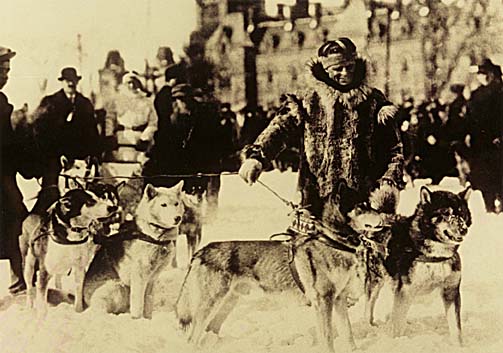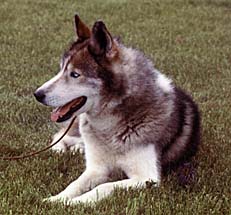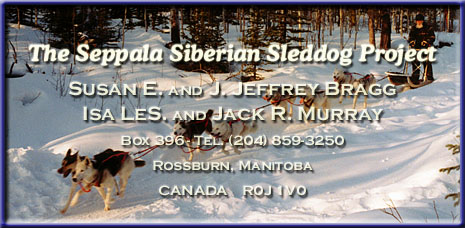Seppala Siberian Sleddog HistoryCopyright
©2003 by J. Jeffrey Bragg
The paragraphs below summarise that history in brief, with links to pages which expand each phase of Seppala development. Along with these history pages, we also offer through the courtesy of Elsie Chadwick (Siberian Husky Archives) an opportunity to view many fascinating images of Seppalas and Seppala teams of the past in our HISTORIC PHOTOS Gallery.
LEONHARD SEPPALA took the raw material of native dogs imported from eastern Siberia and made it into one of the most dependable and efficient varieties of working dogs on earth. His brief Poland Spring partnership with Elizabeth Ricker from 1927 through 1931 established the Seppala strain in New England and Quebec, giving Seppala dogs a reputation as the very best versatile working sleddogs to be had.
HARRY WHEELER in St. Jovite Station, Quebec, acquired foundation stock in 1931 from Seppala and Ricker to establish the second Seppala Kennels, which lasted for twenty years and provided a genetic base not only for Seppala Siberian sleddogs but for the Siberian Husky show dog as well.
EVA B. SEELEY'S CHINOOK KENNELS developed and promoted show-dog bloodlines from a mix of Seppala's breeding and other sources in Alaska, also starting around 1930. Considerable Wheeler stock was added to the mix, but selection and breeding favoured the development of a show-dog type unsuited to serious sleddog purposes. The Seeley lines were shunned by major Seppala breeders.
ALEC BELFORD AND HIS SON CHARLIE obtained Seppala stock from Poland Spring around 1930. They bred, raced and exchanged stock with other Seppala breeders through the following quarter century and beyond.
WILLIAM L. SHEARER III acquired Seppalas for his Foxstand Kennels from Poland Spring, the Belfords and Wheeler. He, too, bred, raced and exchanged stock with others through the next quarter century, establishing a strong working bloodline that was crucial to Seppala survival during the McFaul era.
MARIE FROTHINGHAM AND HER DAUGHTER MILLIE TURNER also acquired Seppalas in the 1930s, primarily from the Wheeler kennel. Their "Cold River" bloodline was strong through the mid-1950s but was finally assimilated into the growing Siberian Husky show-dog bloodlines.
J. D. MCFAUL of Maniwaki, Quebec, obtained Siberians in 1942 from Shearer and Wheeler, then bought the remaining Wheeler stock in 1950 and resold much of it to Shearer. He obtained additional stock from Shearer and provided Seppalas to Keith Bryar (Laconia, NH) and J. M. McDougall (Ste. Agathe des Monts, Quebec). The McFaul dogs and their offshoots provided the basis for the 1970s rescue of Seppala strain from impending extinction.
THE MARKOVO KENNELS RESCUE PROJECT snatched Seppala strain from the jaws of oblivion over a five-year period similar in some ways to the brief Poland Spring epic. The Markovo stock was dispersed in 1975 to provide a fresh chance for the survival of Seppala strain.
THE POST-MARKOVO YEARS brought back the old spectre of assimilation of Seppalas into other bloodlines. The Sepp-Alta breeding of Doug Willett carried the pure Seppala strain into the 1990s but also produced a growing body of stock mixed with Seeley lines as Willett experimented with cross-straining and abandoned the guiding principles of Wheeler, Shearer, Belford and McFaul.
CAROLYN RITTER'S RIVER VIEW KENNELS was the last major pure-Seppala breeding kennel in the USA from 1988 through 1993. Starting with stock from the Windigo Kennels of Deborah Serbousek and from Doug Willett, Carolyn raced for several years. Her breeding provided a crucial bridge from the Markovo stock to the SSSD Project.
THE SSSD PROJECT HAD ITS BEGINNINGS in Spain when J. Jeffrey Bragg and Isa Boucher resumed Seppala breeding with pure-strain stock from Ritter, Willett and others. Today the Project strives to advance traditional Seppala values against the growing confusion of cross-strain racing Siberian Husky stock and part-Seppalas.

(Elizabeth Ricker driving the team, Ted Ricker just left of her)
Dogs in the foreground are (left to right) Bijou, Kree Vanka, Bonzo, Tserko.
(Photo courtesy Elsie Chadwick, Siberian Husky Archives)





